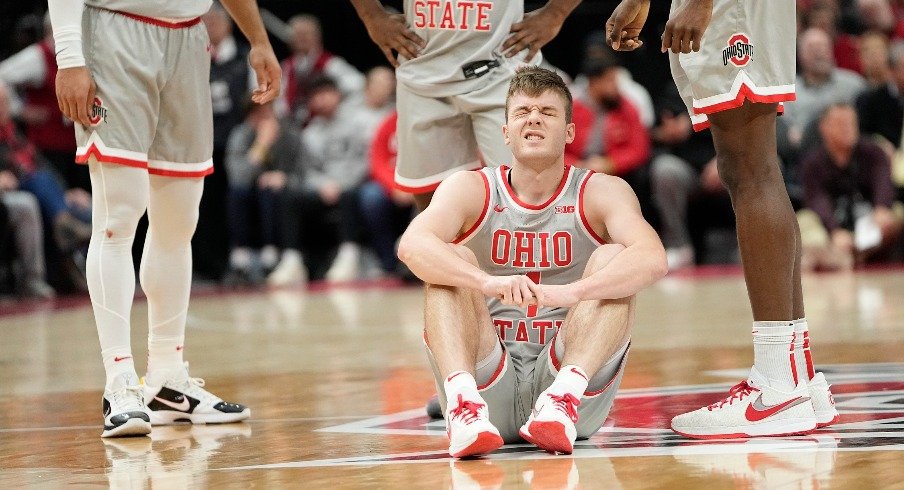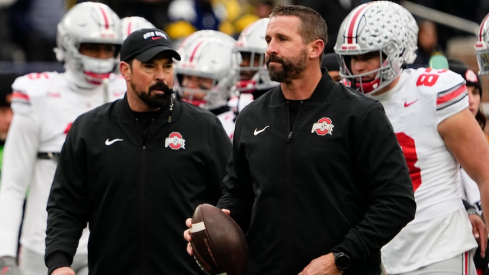The good news: Ohio State won’t have to play any more games in the month of January.
The bad news: That doesn’t guarantee it will play any better from here on out.
Before Ohio State can turn things around in the final 10 games of the regular season, it must understand what’s gone wrong amid its recent struggles. The past four weeks haven’t been kind to the Buckeyes, as they’ve dropped seven of their last eight games to finish January with a 2-7 record. Ohio State is only one game above .500 and now sits in 12th place in the Big Ten standings.
However, it’s not as though Chris Holtmann and company are clueless as to what their problems have been of late. The Buckeye head coach repeatedly named rebounding among Ohio State’s primary issues during his Monday press conference at the Schottenstein Center, and mentioned several other areas as central points of improvement.
“I think continued ball movement. Offensively, the ball’s gotta move more than it has in stretches,” Holtmann said. “I’d like for us to shoot a little bit better and probably take a few more threes than what we’ve taken. And then just generally, our defense. Our transition defense and our defense I thought had taken some strides, but it took a step back in the Indiana game.”
As Ohio State prepares to begin the second half of Big Ten play with a 7 p.m. matchup against Wisconsin on Thursday, let us first examine each of those concerns to quantify the Buckeyes’ decline over the past month.
Rebounding
Ohio State lost the rebounding battle in five of its nine games in January. The Buckeyes lost every one of those contests. In fact, they’ve dropped every game in which they finished with fewer rebounds than their opponent this season, although it’s happened far more frequently since the start of the new year.
Before January, Ohio State averaged 40.5 rebounds per game across 12 contests. In that stretch, the Buckeyes’ opponents only averaged 31.2 boards. Ohio State finished with a rebounding deficit in only three of those contests (San Diego State, Duke and North Carolina).
Even if you take Ohio State’s six buy games out of the equation, the Buckeyes still held the overall rebounding edge against their six higher-caliber opponents pre-January. The Buckeyes averaged 35 rebounds per game in those matchups, while their opponents grabbed an average of 33.3.
Since the start of January, though, Ohio State’s averaged nearly five fewer boards per game overall (35.7). The Buckeyes’ adversaries have pulled down 37.9 rebounds a night in that stretch. Ohio State still possesses the fifth-best rebounding margin in the Big Ten through 21 games (4.3), but that number continues to shrink as the Buckeyes lose the battle on the glass.
Ball Movement
Ohio State averages the third-fewest assists in the conference with 12.4. The Buckeyes averaged 14.4 per game before January. Had they continued that pace in the subsequent nine games, they’d rank among the top seven teams in the Big Ten.
In the last nine games, though, Ohio State isn’t even averaging 10 assists per game. The Buckeyes are dishing just 9.7 assists a night since the start of the new year, which would rank dead last in the conference if it was Ohio State’s full-season average.
| STAT | BEFORE JAN. | IN JAN. |
|---|---|---|
| PPG | 81.7 | 69.9 |
| FG% | 49.4% | 42.7% |
| 3FG% | 37.3% | 39.6% |
| 3PA | 20.8 | 16 |
| RPG | 40.5 | 35.7 |
| APG | 14.4 | 9.7 |
Ohio State finished only three of its first 12 games without a double-digit assist total, and it had 15 or more in six different contests. The Buckeyes had at least 20 dimes in two of those games. From January onward, though, Ohio State hasn’t had more than 15 assists in any game.
In fact, the Buckeyes only topped nine assists in three of their nine games in January. Ohio State’s had single-digit assist totals in six of its last seven games, including a season-low five against Minnesota – perhaps the Buckeyes’ worst loss of the season.
No individual Buckeye is even averaging three assists per game this year, as Isaac Likekele leads the team with an average of 2.9.
Shooting
Before January, Ohio State was one of the elite shooting teams in the Big Ten. Actually, it still is. The Buckeyes’ 46.6% clip from the field still ranks second in the conference behind only Indiana. But the Buckeyes’ shot-making efficiency has dropped nearly 7% in the last nine games.
Ohio State knocked down nearly half of its shots (49.4%) in the first 12 contests. Since then, the Buckeyes are only hitting 42.7% of their attempts. That comes as little surprise when you look at Ohio State’s dip in scoring production as well as its game-by-game shooting performances.
The Buckeyes hadn’t shot below 40% from the field in any game before January. They’ve had four sub-40% efforts in the past six games alone, including a three-game stretch in which they shot just 35.8% combined against Minnesota, Rutgers and Nebraska. The Buckeyes lost all three of those contests.
Ohio State’s had a few hot shooting nights mixed in, hitting 50% of its shots against Purdue and 56.3% in a win over Iowa, but they’ve been few and far between relative to its pre-January pace.
3-Point Attempts
Ohio State is one of the three best 3-point shooting teams in the conference with its 38.2% conversion rate from beyond the arc. And that’s only a fraction of a percentage behind the Big Ten’s first-place team in that category.
But the Buckeyes’ 393 3-point attempts are the third-fewest in the league. So, why aren’t they taking more long-range shots? Holtmann is wondering the same thing, and wants to see his team increase its attempts in the weeks to come.
Ohio State hit 37.3% of its 3-point attempts in the first 12 games, and unlike most other offensive categories, it’s actually improved on that mark since the start of the new year. In the past nine games, the Buckeyes have knocked down 39.6% of their 3-pointers.
However, their output has taken a significant dip. While the Buckeyes shot 20.8 3-pointers on average before January, they only took 16 per game in the first month of 2023. After eight games with at least 20 3-point attempts in the first 12 games, Ohio State has only attempted that many in one game since.
Defense
Holtmann pointed to defense as a potential weak point for the 2022-23 Buckeye roster early in the season. Through 21 games, its 84th-place defensive ranking in KenPom only confirms that notion.
| OPP. STAT | BEFORE JAN. | IN JAN. |
|---|---|---|
| PPG | 65.1 | 71.2 |
| FG% | 40.6% | 41.7% |
| 3FG% | 27.2% | 33.6% |
| RPG | 31.2 | 37.9 |
| FTA | 14.6 | 18.8 |
But while the Buckeye head coach had thought his team was making progress on that end of the floor, he called Saturday night’s performance against Indiana “our poorest defensive output on the year.”
Statistically, defensive improvements haven’t been easy to find when comparing Ohio State’s performance before and since the start of the new year. In November and December, the Buckeyes gave up an average of 65.1 points per game on 40.6% shooting from the field and 27.2% from 3-point range. Since then, opponents are averaging 71.2 points against the Buckeyes on 41.7% shooting from the floor and 33.6% from three.
And that’s to say nothing of the rebounding discrepancy, which we already discussed in detail.
Opponents are getting to the free-throw line 4.2 more times per game against Ohio State since the start of January, and they’re shooting nearly 3% better from the line – not that the latter stat has anything to do with the Buckeye defense.
Individual Performers
Of the seven Buckeyes who started multiple games in January, only Brice Sensabaugh and Sean McNeil actually upped their scoring average over the course of the month. In Sensabaugh’s case, it was a significant boost, as the freshman averaged 15.8 points before January and 20.1 in the last nine games. McNeil only put up 0.6 more points over the past month than he did prior.
| PLAYER | BEFORE JAN. | IN JAN. |
|---|---|---|
| BRUCE THORNTON | 10.8 PPG, 50.5% FG | 5.4 PPG, 27.4% FG |
| SEAN MCNEIL | 9.5 PPG, 42.4% FG | 10.1 PPG, 41.4% FG |
| BRICE SENSABAUGH | 15.8 PPG, 4.2 RPG | 20.1 PPG, 7.3 RPG |
| ISAAC LIKEKELE | 4.2 PPG, 5.8 RPG | 3.4 PPG, 3.4 RPG |
| JUSTICE SUEING | 13.5 PPG, 45.5% FG | 11.2 PPG, 42.7% FG |
| ZED KEy | 13.6 PPG, 63.9% FG | 9.3 PPG, 46.6% FG |
| FELIX OKPArA | 4.3 PPG, 3.8 RPG | 2.8 PPG, 2.6 RPG |
Even then, both players saw their field-goal percentages decrease.
For the other five players, there’s been a sharp decline in most major statistical categories. Bruce Thornton’s drop-off may be the most dramatic of all. The freshman guard averaged 10.8 points on 50.5% shooting in the first 12 games, hitting 47.2% of his 3-pointers and adding 3.3 assists and 2.9 rebounds per game. In the last nine games, Thornton’s only averaged 5.4 points, 2.1 assists and 2.7 rebounds while shooting just 27.4% from the field and 27.3% from beyond the arc.
Zed Key’s production has also tapered off as the Buckeye big man has dealt with multiple injuries. Key averaged 13.6 points on 63.9% shooting and 8.2 rebounds in the first 12 games. Since then, Key’s putting up just 9.3 points on 46.6% shooting with 6.8 rebounds per game.
Statistically, Justice Sueing’s decline hasn’t been quite as dramatic, although he’s received plenty of criticism for his play during the Buckeyes’ rough stretch. The sixth-year forward was even removed from the starting lineup in the two games that preceded Saturday’s Indiana loss. Sueing is averaging 2.3 fewer points per game in the last nine games than he did in the previous 12, and shooting 2.8% worse from the field.
Sueing and Key are two of Ohio State’s captains and foremost veteran leaders. Thornton, while only a freshman, is the Buckeyes’ starting floor general and plays the second-most minutes per game on the team. Given that all of them have struggled since the start of January, it’s little surprise the team has followed suit.


